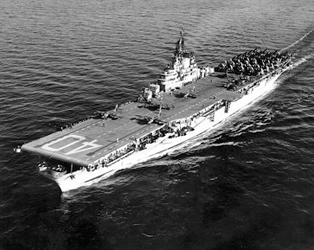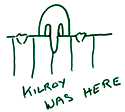The Stamford Historical Society Presents
Pride and Patriotism: Stamford’s Role in World War II
Online Edition
Biography
 The interview below is from AN AMERICAN TOWN GOES TO WAR by Tony Pavia, 1995, ISBN: 1563112760
The interview below is from AN AMERICAN TOWN GOES TO WAR by Tony Pavia, 1995, ISBN: 1563112760
The book may be viewed at the Marcus Reseach Library of the Stamford Historical Society.
With permission by the author.
The DiPreta Brothers – TonyTony DiPreta
Tony DiPreta was the sixth of the seven brothers to enter the service. He was among many Stamford High School boys who were given early graduation in March of 1943 to join the war effort. Aboard the AK Cargo Ship the USS Appanoose, he saw action in the Pacific including three months at Okinawa.
 After boot camp I was stationed in Washington, D.C., and we were part of a communications outfit. I could have stayed there until the end of the war but in the back of my head I had this feeling that I should he out at sea. I didn’t want to sit the war out in Washington, D.C. When my brother Jimmy was killed I wanted a transfer and I volunteered for sea duty.
After boot camp I was stationed in Washington, D.C., and we were part of a communications outfit. I could have stayed there until the end of the war but in the back of my head I had this feeling that I should he out at sea. I didn’t want to sit the war out in Washington, D.C. When my brother Jimmy was killed I wanted a transfer and I volunteered for sea duty.
Jimmy was really a Gung-Ho Marine. He was a very special guy. He was a few years older than me and he was my hero. He was very popular, good looking and had lots of friends. When I got to high school it was very intimidating to me because everyone liked him so much. I was shy and in a lot of ways I didn’t measure up. He was always upbeat, had a terrific sense of humor and was the family favorite. He loved the Marines and was so proud to be one. Just before he died, he was in a newsreel done a day or two before the invasion of Tarawa. They showed some of the guys at mass before they boarded the ship. The film showed Jimmy receiving Communion.
After Washington, D.C., the first place we went was to the Philippines. We weren’t involved in the invasion but we came in afterward. We were carrying the Sea Bees and these big square blocks that they were going to use to make wharves, piers, barges, and that sort of thing.
On Christmas Eve of 1944, a friend and I were sitting on deck, lamenting about our sad state and thinking about our families back home. Pretty soon we heard an airplane flying overhead and the two of us were trying to figure out what kind it was – a PBS – a Corsair? All of a sudden the plane shuts off its engine and drops a torpedo. We stood there mesmerized, watching the wake of the torpedo go right across our bow and smack into the ship right next to us. The instant the torpedo hit, we saw white hot and then red hot flames. It blew a hole as big as this room. That was our first taste of action.
I guess the pilot bailed out and in the confusion someone called out for a lifejacket and one of our crew threw one overboard. It was pretty embarrassing because later they found the pilot on the island of Samar and he was wearing a lifejacket with our name stenciled right on it.
The main danger for us was always kamikazes. Later when we were sent to Okinawa right after the original invasion, it was the height of the kamikaze planes. (At this point in the war, with their resources dwindling and a shortage of experienced pilots, the Japanese decided on a great kamikaze offensive to be used against the American fleet at Okinawa. This offensive was named “Ton-Go”, which translated means Heavenly Operation.) We lived day after day under the threat of kamikaze attack. You’d see a ship in front of you hit, to the left of you get hit, behind you get hit. One day I was up on the bridge with the Captain. I was the “Captain’s talker” which meant that I communicated his orders to the rest of the ship. We saw the plane coming right at us – and he missed us. The pilot had to be inexperienced because he was so bad he just plain missed us. At Okinawa we got to the point where we said, “What’s the point of brushing our teeth, we’re all going to die tomorrow.” And that’s just how you felt because they were relentless.
We were at Okinawa for over 90 days and we spent most of these days anchored in the same spot. This is when you were in the greatest danger. The only time we moved was if a ship was headed back for the states, we would go over to get their fresh fruit and food. The Japanese not only had kamikaze planes but we were told that they had kamikaze boats and kamikaze swimmers too. The swimmers were the most frightening because you had no warning. We were told that they’d climb on board a ship at night, get into the sleeping quarters, slit a man’s throat, and then leave. This never happened on our ship but you can imagine the psychological impact that these stories had on the men. So we had guard duty every night and walked around with Thompson Sub Machine Guns. If you saw anything you shot. Well, most of us had no experience with machine guns. What the hell did we know? We were sailors. Every once in a while a guy would think he spotted something and start shooting. Before you knew it everyone was shooting, and it sounded like the fourth of July.
The suicide boats were barges loaded with dynamite. One of these barges hit our ammunition ship and sunk it. We couldn’t even see it because at the time, we had laid out a smokescreen.
The only time we got a real break from the kamikazes was when a typhoon was coming, because then they made us go out to sea. We had three typhoons at Okinawa and sometimes you’d see an entire ship disappear under the waves. It was probably for only three or four seconds but it seemed like these big ships were just being swallowed up. One time I was in the flying bridge, the uppermost part of the bridge. At one point the ship turned and it was almost touching the water. Fortunately, at the age of 19 you don’t have any fear.
Once we had these guys come aboard and tell us how we had it made, how we got hot food and could shower every day. But we said, “At least you guys have somewhere to hide.” Later we got a prolonged kamikaze attack and these guys couldn’t get off the ship fast enough.
Once there was a destroyer about a half mile away. On the stern of the deck they carried depth charges. A kamikaze came in and slammed right into the deck and the depth charges. You could see the entire ship lift out of the water and only half of it came down. No one who was on that half could have survived. We were so lucky because we were one of the few ships out there that didn’t get hit. I still say that if the Japanese had started earlier and had more skilled pilots, it would’ve been a longer war.
Later, when we docked in Saipan I asked the Commanding Officer if I could go ashore and try to find my brother Nick, who was there. He said yes and so a friend and I got off the ship. We weren’t too far away when I noticed that the ship was underway. It was leaving! We raced to catch up with the ship and they threw us down a Jacob’s ladder and we climbed back on. I never did get to see my brother. And he was less than a quarter mile away.
When the war was over I went to the Hollywood Canteen and they had a register book. I signed in. I looked at the list from the day before and I saw the name Nick DiPreta. I missed him by one day.
 Once we were out at sea and I saw an LST. I knew by the number that I had a friend on board. So I signaled over to them. “Is Larry Nemchek aboard?” They answered affirmative and about an hour later he came aboard and we laughed and had a nice little visit. Of course it wasn’t the best place in the world to meet.
Once we were out at sea and I saw an LST. I knew by the number that I had a friend on board. So I signaled over to them. “Is Larry Nemchek aboard?” They answered affirmative and about an hour later he came aboard and we laughed and had a nice little visit. Of course it wasn’t the best place in the world to meet.
Toward the end of the war I transferred off our ship and ended up on a new carrier The U.S.S. Tarawa. I specifically requested this ship because of my brother. I was on that ship until the end of the war.
Tony returned to Stamford in 1946. He worked for AMF in Stamford and later for the Lifesaver Company in Port Chester where he worked until his retirement.
© Anthony Pavia, 1995
The Fighting DiPretas
 Introduction
Introduction
Veterans
Battles
Stamford Service Rolls
Homefront
Exhibit Photos
Opening Day

